
Series of videos that can be used in an AP Biology Labs class created by Paul Anderson- Bozeman Science
- Subject:
- Biology
- Life Science
- Material Type:
- Lecture
- Provider:
- Bozeman Science
- Date Added:
- 11/23/2016

Series of videos that can be used in an AP Biology Labs class created by Paul Anderson- Bozeman Science

These exercises cover the Science Practices for Advanced Placement Biology. They were written by Julie Zedalis and John Eggebrecht, and include alignment information to the College Board AP Biology Course and Exam Description. The exercises are also available directly in the OpenStax AP Biology textbook.

Paul Anderson's video play list of videos that can be used in a AP Biology Science Practices course

Series of videos that can be used in a AP Biology Video Essentials class created by Paul Anderson- Bozeman Science

ESTE PRODUTO EDUCACIONAL FOI PRODUZIDO A PARTIR DE UM ESTUDO DE PESQUISA DE MESTRADO,VOLTADO A CAPACITAÇÃO DE PROFESSORES DA EDUCAÇÃO BASICA NA MODALIDADE ESPECIAL.O QUAL FOI PRODUZIDA UMA SEQUENCIA DIDÁTICA COMO ESTRATEGIA DIDÁTICA PARA SE TRABALHAR O TEMA ARBORIZAÇÃO URBANA E EDUCAÇÃO AMBIENTAL.

This resource is a video abstract of a research paper created by Research Square on behalf of its authors. It provides a synopsis that's easy to understand, and can be used to introduce the topics it covers to students, researchers, and the general public. The video's transcript is also provided in full, with a portion provided below for preview:
"Immune checkpoints are an effective way that cancers evade the immune system, but they're not the only one. In the case of pancreatic ductal carcinoma, or PDAC, tumor fibrosis also plays an important role. To understand how fibrosis might translate to poor outcomes among patients with PDAC, researchers examined the ARF6-AMAP1 molecular pathway, which research suggests is activated during fibrosis. Findings revealed that AMAP1 correlated with elevated expression of PD-L1, a molecule that tumor cells present on their surface to elude attack by the immune system. AMAP1 was also linked to elevated fibrosis. Consistently, silencing AMAP1 in a mouse model of human PDAC reduced PD-L1 and fibrosis in their tumors. Suppressing the ARF6-AMAP1, therefore, could be one way to ensure that PDAC tumors can’t hide from immune defenses, offering the prospect of more effective immunotherapies for patients with pancreatic ductal carcinoma..."
The rest of the transcript, along with a link to the research itself, is available on the resource itself.

Poor research reporting is a major contributing factor to low study reproducibility, financial and animal waste. The ARRIVE (Animal Research: Reporting of In Vivo Experiments) guidelines were developed to improve reporting quality and many journals support these guidelines. The influence of this support is unknown. We hypothesized that papers published in journals supporting the ARRIVE guidelines would show improved reporting compared with those in non-supporting journals. In a retrospective, observational cohort study, papers from 5 ARRIVE supporting (SUPP) and 2 non-supporting (nonSUPP) journals, published before (2009) and 5 years after (2015) the ARRIVE guidelines, were selected. Adherence to the ARRIVE checklist of 20 items was independently evaluated by two reviewers and items assessed as fully, partially or not reported. Mean percentages of items reported were compared between journal types and years with an unequal variance t-test. Individual items and sub-items were compared with a chi-square test. From an initial cohort of 956, 236 papers were included: 120 from 2009 (SUPP; n = 52, nonSUPP; n = 68), 116 from 2015 (SUPP; n = 61, nonSUPP; n = 55). The percentage of fully reported items was similar between journal types in 2009 (SUPP: 55.3 ± 11.5% [SD]; nonSUPP: 51.8 ± 9.0%; p = 0.07, 95% CI of mean difference -0.3–7.3%) and 2015 (SUPP: 60.5 ± 11.2%; nonSUPP; 60.2 ± 10.0%; p = 0.89, 95%CI -3.6–4.2%). The small increase in fully reported items between years was similar for both journal types (p = 0.09, 95% CI -0.5–4.3%). No paper fully reported 100% of items on the ARRIVE checklist and measures associated with bias were poorly reported. These results suggest that journal support for the ARRIVE guidelines has not resulted in a meaningful improvement in reporting quality, contributing to ongoing waste in animal research.

This resource is a video abstract of a research paper created by Research Square on behalf of its authors. It provides a synopsis that's easy to understand, and can be used to introduce the topics it covers to students, researchers, and the general public. The video's transcript is also provided in full, with a portion provided below for preview:
"The transcription factor ATF5 plays a vital role in the formation of several cancers, including breast, lung, ovarian, pancreatic, rectal, and liver cancer. But ATF5’s function in esophageal cancer—one of the most common forms of cancer worldwide—remains unclear. To find out, researchers monitored the activity of ATF5 in esophageal cancer tissues. Much like in other cancers, ATF5 was upregulated in esophageal cancer tissues cultured in the lab, and ATF5 overexpression promoted the proliferation, migration, and invasiveness of esophageal cancer cells. Silencing ATF5, however, inhibited these abilities. In fact, in mice, silencing ATF5 hampered tumor growth. ATF5’s role as a lever that triggers tumor growth is believed to occur through an interaction with HIF1, a protein complex also known to promote the growth and spread of tumors. These findings suggest that the known anti-cancer effects of silencing ATF5 might also be powerful against esophageal cancer..."
The rest of the transcript, along with a link to the research itself, is available on the resource itself.

Learn more about ATP: how it stores energy, and how that energy is released when it's converted to ADP and phosphate. Created by Sal Khan.

In which Hank does some push-ups for science and describes the "economy" of cellular respiration and the various processes whereby our bodies create energy in the form of ATP.
Chapters:
1) Cellular Respiration
2) Adenosine Triphosphate
3) Glycolysis
A) Pyruvate Molecules
B) Anaerobic Respiration/Fermentation
C) Aerobic Respiration
4) Krebs Cycle
A) Acetyl COA
B) Oxaloacetic Acid
C) Biolography: Hans Krebs
D) NAD/FAD
5) Electron Transport Chain
6) Check the Math
Review
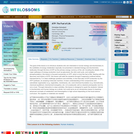
The goal of this lesson is to introduce students who are interested in human biology and biochemistry to the subtleties of energy metabolism (typically not presented in standard biology and biochemistry textbooks) through the lens of ATP as the primary energy currency of the cell. Avoiding the details of the major pathways of energy production (such as glycolysis, the citric acid cycle, and oxidative phosphorylation), this lesson is focused exclusively on ATP, which is truly the fuel of life. Starting with the discovery and history of ATP, this lesson will walk the students through 8 segments (outlined below) interspersed by 7 in-class challenge questions and activities, to the final step of ATP production by the ATP synthase, an amazing molecular machine. A basic understanding of the components and subcellular organization (e.g. organelles, membranes, etc.) and chemical foundation (e.g. biomolecules, chemical equilibrium, biochemical energetics, etc.) of a eukaryotic cell is a desired prerequisite, but it is not a must. Through interactive in-class activities, this lesson is designed to spark the students’ interest in biochemistry and human biology as a whole, but could serve as an introductory lesson to teaching advanced concepts of metabolism and bioenergetics in high school depending on the local science curriculum. No supplies or materials are needed.

In this seminar you will read closely and analyze the structure of ATP- Adenosine Triphosphate. You will curate your own information about the importance of ATP in a cell by listening and reading text as to what the experts have to say. By modeling the function of ATP in an inquiry lab you can accurately identify the various levels of cellular work done by Adenosine Triphosphate.StandardsBIO.A.3.1.1 Describe the fundamental roles of plastids (e.g., chloroplasts) and mitochondria in energy transformations.BIO.A.3.2.1 Compare and contrast the basic transformation of energy during photosynthesis and cellular respiration.BIO.A.3.2.2 Describe the role of ATP in biochemical reactions

ATP synthase and its role in mitochondria during respiration and chloroplasts during photosynthesis.
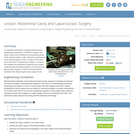
For students interested in studying biomechanical engineering, especially in the field of surgery, this lesson serves as an anatomy and physiology primer of the abdominopelvic cavity. Students are introduced to the abdominopelvic cavity—a region of the body that is the focus of laparoscopic surgery—as well as the benefits and drawbacks of laparoscopic surgery. Understanding the abdominopelvic environment and laparoscopic surgery is critical for biomechanical engineers who design laparoscopic surgical tools.

This resource is a video abstract of a research paper created by Research Square on behalf of its authors. It provides a synopsis that's easy to understand, and can be used to introduce the topics it covers to students, researchers, and the general public. The video's transcript is also provided in full, with a portion provided below for preview:
"The non-receptor tyrosine kinase Abelson (Abl) is a key player in oncogenesis, causing diseases including chronic myelogenous and acute lymphoblastic leukemia. Drugs targeting Abl kinase activity serve as paradigms of targeted therapy. Drosophila is an ideal model for studying Abl’s function because there is only a single fly Abl family member. In flies, Abl is essential for embryonic morphogenesis, playing diverse roles in embryonic and adult viability. To examine the role of the intrinsically disordered region (IDR) of Abl, researchers deleted the IDR in Drosophila. They found that Abl lacking the IDR was not able to rescue the roles of Abl in viability and embryonic morphogenesis. The IDR was also essential for cell shape changes and cytoskeletal regulation during embryonic morphogenesis and, surprisingly, for modulating protein stability..."
The rest of the transcript, along with a link to the research itself, is available on the resource itself.
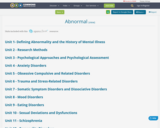
Selection of reading resources for Abnormal Psychology courses.
These resources were compiled by Dr. Susan Harvey, Professor at Delta College
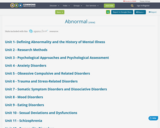
Selection of reading resources for Abnormal Psychology courses.
These resources were compiled by Dr. Susan Harvey, Professor at Delta College

Introduction to the linguistic study of language pathology, concentrating on experimental approaches and theoretical explanations. Discussion of Specific Language Impairment, autism, Down syndrome, Williams syndrome, normal aging, Parkinson’s disease, Alzheimer’s disease, hemispherectomy and aphasia. Focuses on the comparison of linguistic abilities among these syndromes, while drawing clear comparisons with first and second language acquisition. Topics include the lexicon, morphology, syntax, semantics and pragmatics. Relates the lost linguistic abilities in these syndromes to properties of the brain.
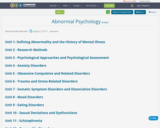
Selection of reading resources for Abnormal Psychology courses.
These resources were compiled by Dr. Susan Harvey, Associate Professor at Delta College
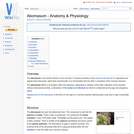
The abomasum is the fourth chamber in the ruminant. It functions similarly to the carnivore stomach as it is glandular and digests food chemically, rather than mechanically or by fermentation like the other 3 chambers of the ruminant stomach.